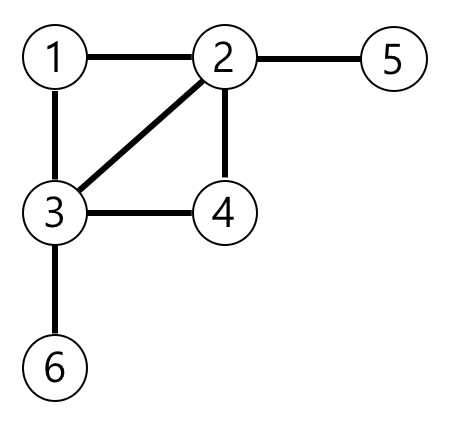프로그래머스 - 가장 먼 노드
나의 풀이

1. 근접 노드를 구하자
1의 근접 노드는 2,3
2의 근접 노드는 1,4,5
3의 근접 노드는 1,4,6
4의 근접 노드는 2,3
5의 근접 노드는 2
6의 근접 노드는 3
var nearNode: [[Int]] = []
nearNode = Array(repeating: [], count: n+1)
edge.forEach{
nearNode[$0[0]].append($0[1])
nearNode[$0[1]].append($0[0])}2. 방문한 노드를 체크하자
방문한 노드를 체크해야되는 이유는
- 재방문 금지 : 1 -> 2 -> 1
- 최단 경로만 허용 : 1 -> 3 -> 2 -> 5와 같이 1에서 5로 가는 최단경로(1 -> 2 -> 5) 가 아닌 경우를 방지하기 위해
var visited: [Bool] = []
visited = Array(repeating: false, count: n+1)3. bfs로 탐색해보자
- 1부터 시작해야 되니 result에 우선 1을 넣어준다.
- 노드 1을 bfs 탐색한다.
2-1. 노드 1의 인접 노드(2, 3)를 visited = true하여 방문 표시한다.
2-3. result의 노드 2와 노드 3을 넣어준다. - 노드 2를 bfs 탐색한다.
3-1. 노드 2의 인접 노드인 1이 visited = true 이기 때문에 방문하지 않는다.
3-2. 노드 2의 인접 노드인 4가 visited = false 이기 때문에 방문 후(visited = true) result의 노드 4를 넣어준다.
3-3. 노드 2의 인접 노드인 5가 visited = false 이기 때문에 방문 후(visited = true) result의 노드 5를 넣어준다. - 노드 3을 bfs 탐색한다.
4-1. 노드 3의 인접 노드인 1이 visited = true 이기 때문에 방문하지 않는다.
4-2. 노드 3의 인접 노드인 4가 visited = true 이기 때문에 방문하지 않는다.
4-3. 노드 3의 인접 노드인 6가 visited = false 이기 때문에 방문 후(visited = true) result의 노드 6을 넣어준다.
.
.
.
이런식으로 진행하다보면 제일 깊이 있는 노드의 갯수를 구할 수 있다.
var result: [Set<Int>] = [[1]]
var depth = 1
visited[1] = true
while result.last!.count > 0{
result.append([])
for node in result[result.count - 2]{
bfs(node, depth)
}
depth += 1
}
func bfs(_ s: Int,_ depth: Int){
nearNode[s].forEach{
if !visited[$0]{
visited[$0] = true
result[depth].insert($0)
}
}
}전체 코드
import Foundation
var nearNode: [[Int]] = []
var visited: [Bool] = []
var result: [Set<Int>] = [[1]]
func solution(_ n:Int, _ edge:[[Int]]) -> Int {
nearNode = Array(repeating: [], count: n+1)
visited = Array(repeating: false, count: n+1)
edge.forEach{
nearNode[$0[0]].append($0[1])
nearNode[$0[1]].append($0[0])}
var depth = 1
visited[1] = true
while result.last!.count > 0{
result.append([])
for node in result[result.count - 2]{
bfs(node, depth)
}
depth += 1
}
result.removeLast()
return result.last?.count ?? 0
}
func bfs(_ s: Int,_ depth: Int){
nearNode[s].forEach{
if !visited[$0]{
visited[$0] = true
result[depth].insert($0)
}
}
}2시간 고민하다 풀이 참고하고 다시 풀어보았다. 뭔가 풀릴것 같으면서도 시간초과로 절대 안풀리는 문제 .. 😭
